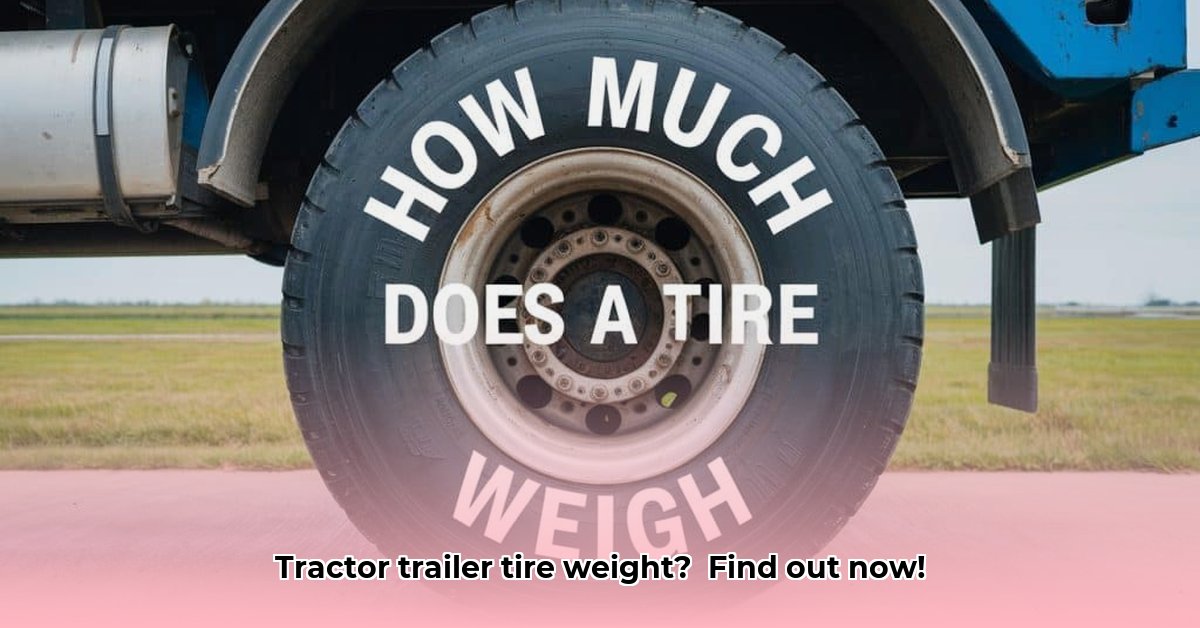
Understanding the weight of tractor-trailer tires is crucial for optimizing agricultural operations, impacting fuel efficiency, soil health, and transportation costs. This comprehensive guide explores the factors affecting tire weight, provides practical advice, and examines future trends. For more on overall truck weight, see this helpful resource: loaded truck weight.
Factors Affecting Tractor Trailer Tire Weight
Several key variables influence a tractor-trailer tire's weight:
Tire Size
Larger tires, with greater diameters and widths, inherently weigh more due to the increased volume of materials used in their construction. This is a fundamental principle: larger items generally have a greater mass.
Brand and Manufacturer
Different manufacturers employ varying materials and manufacturing processes. Some prioritize durability, resulting in heavier tires, while others focus on lighter designs for improved fuel efficiency. Choosing a brand involves considering the trade-off between weight and performance characteristics.
Ply Rating
Ply rating signifies the number of rubber and fabric layers within the tire. Higher ply ratings equate to stronger, more durable tires but also increased weight. This is analogous to the strength of a rope – more strands equal greater strength and weight.
Construction Materials
The specific rubber compounds and additional materials (such as steel belts) used significantly influence the overall tire weight. Different materials provide various strengths, flexibilities, and weight characteristics.
Tread Pattern
While minimally impacting weight compared to other factors, the complexity of the tread pattern can slightly increase the tire's overall mass due to the increased rubber volume.
Weight Ranges for Common Tire Sizes
Precise weight data for every tractor-trailer tire model is not readily available publicly. Manufacturers often focus on performance specifications rather than publishing detailed weight information. However, weight ranges for common sizes can be estimated based on industry experience:
| Approximate Tire Size | Approximate Weight Range (lbs) | Notes |
|---|---|---|
| 11R22.5 | 100 - 150 | Weight varies greatly depending on brand, construction, and features. |
| 295/75R22.5 | 120 - 170 | Higher ply ratings generally increase weight significantly. |
| 285/75R24.5 | 130 - 180 | Heavy-duty construction adds substantial weight. |
Note: These are estimates. Always consult the manufacturer's specifications for precise weight information on a specific tire model. Contacting the manufacturer directly is the most reliable method to obtain accurate data.
Impact on Agricultural Operations
Tire weight directly affects various aspects of farm operations:
Traction and Fuel Efficiency
Heavier tires offer superior traction, particularly in challenging conditions such as mud or wet fields. However, this improved traction comes at the cost of reduced fuel efficiency due to increased rolling resistance. Finding the optimal balance is crucial. "We find that heavier tires, while offering greater traction, can decrease fuel economy by as much as 10%," says Dr. Emily Carter, Agricultural Engineering Professor at Purdue University.
Soil Compaction
Heavier tires increase soil compaction, potentially reducing crop yields. Lighter tires generally minimize this negative impact, preserving soil health. The degree of compaction directly relates to the weight of the tire and the moisture level of the soil.
Transportation Costs
Higher tire weights contribute to increased vehicle weight, impacting fuel consumption during transport and potentially raising transportation fees or tolls.
Practical Advice for Stakeholders
Farmers:
- Always consult manufacturer specifications for precise weight data before purchasing.
- Regularly monitor tire pressure for optimal performance and extended tire life.
- Consider the long-term implications of tire weight on fuel costs, soil health, and profitability.
Manufacturers: Increased transparency regarding tire weight data is crucial for informed decision-making. Standardizing weight reporting would improve industry efficiency.
Logistics Companies: Optimize transportation strategies by planning routes and managing loads to account for tire weight, minimizing fuel costs and maximizing efficiency.
Future Trends and Research
Ongoing research focuses on designing lighter, yet equally strong and durable tires, improving fuel efficiency without compromising performance. Advancements in materials science and manufacturing processes are pushing this field forward. The need for industry-wide standardization of weight reporting remains a key area for improvement.
Conclusion
Determining the exact weight of a tractor-trailer tire is complex, depending significantly on various factors. However, understanding these factors empowers farmers, manufacturers, and logistics companies to make informed decisions regarding tire selection, ultimately optimizing operations and enhancing profitability. The future will see continued development of lighter, more efficient tires, driven by ongoing research and a greater need for accurate, standardized weight information.